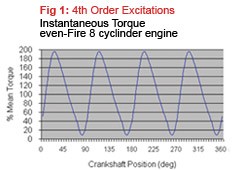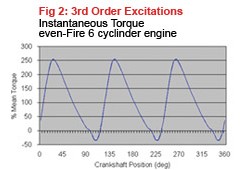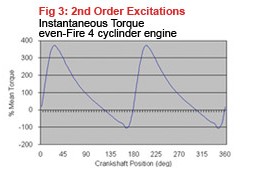Engine Components
TuffBond® Harmonic Balancers / Pulleys
|
Why are
TuffBond®
Harmonic balancers so different? These premium Harmonic balancers are manufactured using the unique TuffBond® process: Precision CNC machined high tensile alloy steel hub and vibration dampening ring Special formula dampening elastomer rubber absorbs more damaging torsional vibrations Exclusive TuffBond® elastrometic bonding process creates an intermolecular bond Improved vibration dampening - increases engine life - quicker engine acceleration Never requires maintenance or rebuilding - ever! Each unit is balanced, painted - oil seal area is treated with preservative to prevent rust. Lifetime warranty, even for racing - a world first! Utilizing the ORIGINAL TuffBond® elastrometic bonding process**. **(a similar process to that used by Mercedes and BMW in production of balancers and mounts) |
By comparison: Balancers manufactured using traditional dampening materials and assembly methods are prone to breakdown through heat and vibration. The twisting forces applied to a balancer - particularly in performance applications - causes spinning and loss of timing accuracy. Some manufacturers knurl the metal faces exposed to the dampening material in an effort to reduce spinning. Subjected to constant vibrations, dampening contact problems and, eventually, breakdown of dampening material results. See Balancer Tech. |
BALANCER TECH.
| Balancer ?? | Harmonic Damper How does it work ?? |
|
The term Harmonic Balancer may be a
little confusing at first. As it is not necessarily fitted to 'balance' the engine's rotating mass, rather to dampen (or control) harmonic vibrations within that assembly. Vibrations exist in any engine. These vibrations are caused by the effects of gas pressures, firing order and inertia of moving engine parts. Partly due to the high pressure reversals encountered during the engine cycle the resultant vibrations cause deflection and twisting of the crankshaft. This is usually referred to as 'torsional harmonic vibration'. Over the years engine manufacturers have taken steps to address these vibration problems. However, these may need revision when serious engine modifications have been performed. |
A harmonic vibration damper keeps
the crankshaft from being destroyed by torsional
vibration. Usually fitted to the nose of the crankshaft to absorb and dissipate the vibratory energy (and cancel vibration if they’re done right). This energy is released in the form of heat. Elastomer Dampers Elastomer dampers are frequency responsive. Using an inertia ring separated from the crank by an elastomer bonded between the weight and the mass of the crankshaft. At the predetermined frequency, this inertia ring is 'resisting' the crankshaft torsional thereby reducing or cancelling out the torsional force. The elastomer compound separating the hub from the inertia ring is firmly bonded to both parts. In the design phase one of several compounds of elastomer is selected having the desired hardness and rebound characteristics for the application. |
| Torsional Vibration |
|
Torsion is a twisting force. A piece of metal will twist when sufficient torque is applied. A steel crank may appear rigid and inflexible but when sufficient force is applied it bends, flexes and twists. Although this elasticity is very small it can have a significant effect on engine operation. Basically, each time a cylinder fires, the intense rise in cylinder pressure (as the air/fuel mixture is ignited) is transferred through the piston and then connecting rod to the crankshaft pin and this tangential force causes the rotation of the crankshaft. As the high pressure eases the crankshaft begins it's return to the untwisted position and, like other 'elastic' objects, it goes beyond it's 'normal' position, then back again. Under normal operating stress, crank twist of as much as 4 to 5 degrees has been reported without an efficient damper. A correctly engineered damper should reduce this to fractions of a degree. It is these torque reversals which are detrimental to an engine's longevity and reliability. In multi-cylinder engines this motion is more complicated as the amplitude of vibration varies along the length of the crankshaft. Greatest amplitude is experienced at the opposite end to the flywheel or applied load. The engine firing order provides the primary source of vibration. In a 4 cylinder four-stroke engine there are 2 combustion cycles per revolution - thus they produce even greater amplitudes of vibrations than a V8 which has four firing impulses each revolution (fourth order vibration), or a 6 cylinder (three firing impulses per revolution -third order vibration). |
WHY??
Fig 1:
Fig 2:
Fig 3: |
| Harmonics | Supercharged Engines |
|
All objects have a natural frequency that they resonate (vibrate) at when
struck. Like a tuning fork, no matter how hard it is hit, it resonates at a predetermined frequency - only the volume and duration will change with the change in amplitude. Similarly, when an uncracked crank is tapped it 'rings' at its natural frequency. Tap it harder and only the volume and duration of the 'ringing' will change. When an object is subjected to an amplified order of it's natural frequency it will begin to resonate in ever increasing amplitude until it suffers fatigue failure (vibrates to pieces). Fatigue failure is easily demonstrated by repeatedly bending a paper clip back and forth. After a few cycles the paper clip will break of fatigue failure. Engine vibrations not only place stresses on the materials in the engine (metal fatigue) they reduce power and torque. If vibrations are not controlled they affect other engine components vital to power production, like valve timing accuracy, spark scatter etc.Harmonics are multiples, or fractions, of a resonant frequency. A crankshaft with a natural frequency of, say, 1000 cycles per second, or “Hertz” (Hz), may compound the natural “ringing” of the crank at 2000 or 500 cycles.The resonant frequency of the crankshaft doesn’t change in operation. Other frequencies created by the speed of piston movement, timing chain slack, camshaft lobes going over full lift and cylinder gas pressures, can compound or cancel crankshaft vibration. Modern car engines will probably pass through a number of vibration periods over their useable rpm range. Most are hardly noticed due to the fact that some harmonics cancel each other out. It is when a combination of harmonics build on one another to amplify the torsional vibration at the crankshaft we have a problem. This is also known as 'critical rpm’s'. If the engine is held at or near this critical rpm for any length of time the crank will probably suffer fatigue failure. This critical rpm must be avoided or at the least damped. A loose or sheared front pulley, a flywheel coming loose, a fatigued clutch cover etc. can be sure signs of running an undamped or incorrectly engineered damper. In addition there are many other sources of vibration inside an engine and drivetrain which also enter the equation. |
Q.
Does the supercharger drive
belt offer enough dampening to suppress crankshaft harmonics? Some supercharger kit suppliers suggest the belt drive can dampen most of the dangerous harmonics. A. Maybe, it's guesswork at best. Depends on belt tensioner (idler), Is it fixed or spring loaded? Without the right tension the belt won’t do much toward dampening anything. Another consideration is the number (or width) of drives hanging off the crank snout. Will it safely support both a blower drive pulley and a harmonic balancer? Even if the snout will accommodate them, a severe load must be borne by the crank snout. The additional weight of the damper may even create new problems. |


